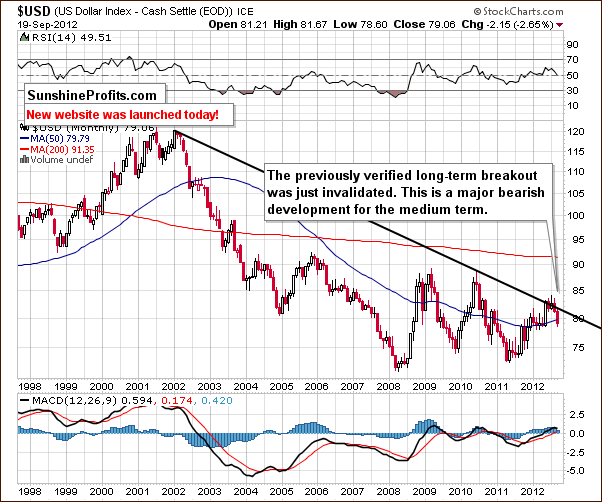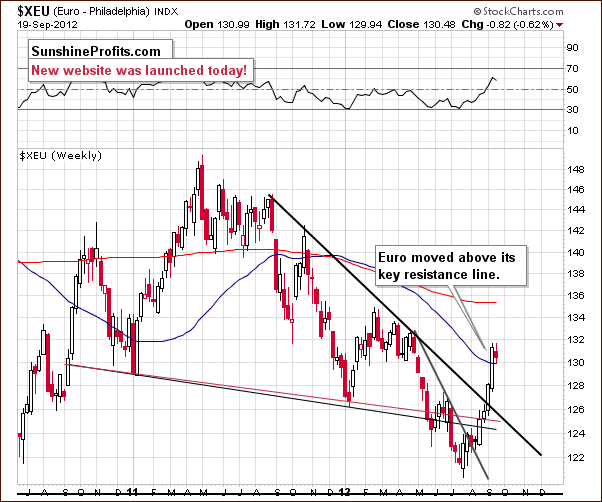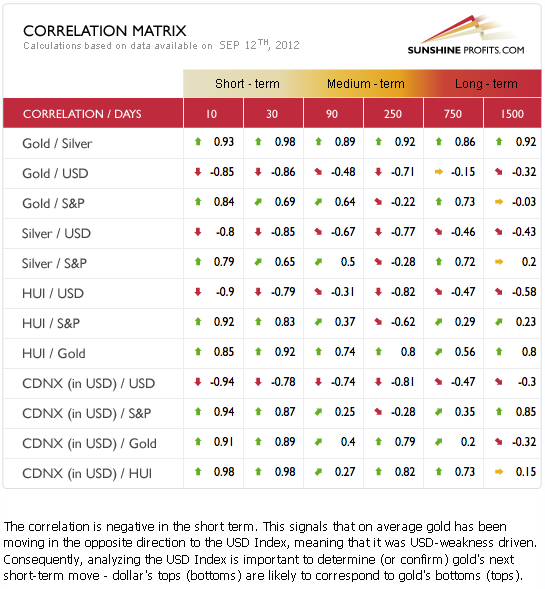Visit our archives for more gold & silver articles.
We recall with some nostalgia that it was last year on September 6, that gold hitan all-time high of $1,923. This of course reminds us that a month before that the credit agency Standard & Poor’s stripped the United States of its AAA rating on its bonds after partisan wrangling over raising the government's debt limit led the nation to the brink of default. And now in addition to nostalgia we get a feeling of déjà vu. The U.S. recently received another warning of a credit downgrade, this time from Moody's Investors Service. The credit agency said last Tuesday that it would most likely cut its Aaa rating on United States government debt, probably by one notch, if Washington's budget negotiations failed. This does not bode well for the U.S. dollar in the long run.
Let’s move to the situation in Europe. When George Soros speaks people usually listen. Soros is a strong supporter of European integration but a longtime critic of Germany’s eurozone crisis management. In his usual forthright manner, Soros recently said in a speech that Europe’s recession will intensify and spread to Germany within six months.
"The policy of fiscal retrenchment in the midst of rising unemployment is pro-cyclical and pushing Europe into a deeper and longer depression," Soros said. "That is no longer a forecast; it is an observation. The German public doesn’t yet feel it and doesn’t quite believe it. But it is all too real in the periphery and it will reach Germany in the next six months or so."
Soros said Germany needs to abandon its demands for austerity in other countries and embrace the continued fiscal unification of the region or leave the euro zone itself. (Recently, German politicians, led byChancellor Angela Merkel, havebegun signaling greater comfort with monetary debasement.) Soros also said it would be preferable for Germany to stay in the euro zone and work to boost growth, activate a debt-reduction fund and guarantee common bonds.
All in all, it seems that both: US and EU are going to debase their currencies, each in hope of gaining a competitive advantage in exports and devaluing its own debt. Who will win this race? Whether it will be the US or EU that will manage to "solve" more problems by printing money, we know that clear winners in the long run will be gold and silver investors and charts appear to confirm that (charts courtesy by http://stockcharts.com.)

Let’s take a look at the long-term USD Index chart. We focus on this chart to analyze the USD Index because last week’s moves have long term and medium term significance.
The major breakout was invalidated last week and the move below the key resistance level is being verified right now. Breakout’s invalidation was truly a very unlikely development. Just by the term itself, breakouts normally hold and are generally not invalidated. The previously broken resistance line normally becomes a support line. With the breakout being invalidated last and this week, a true sign of weakness in the USD Index is clearly seen and points to a bearish outlook for the months ahead.
As you will see in the following part of this essay, it has profound bullish implications for the precious metals market. Meanwhile, let’s take a look at the European currency.

In the long-term Euro Index chart we have quite the opposite situation as compared to the dollar. Now it’s not that the euro is showing strength, but rather the dollar has simply lost much of its appeal relative to the euro and this makes the euro look strong.
The breakout above the key resistance line in the euro was a major bullish factor and the size of the move that followed after the breakout has already verified it. The picture is clearly bullish.
To see how this shift in currencies could impact precious metals in the following weeks, let’s have a look at our Correlation Matrix, intended to gauge the intermarket correlations.

The developments in the markets last week have bearish implications for the USD Index and have created a bullish outlook not only for metals, but also for stocks. This combination has resulted in a rosy picture for the precious metals. The classic mode is in place in this week’s correlations as the miners have moved with stocks and in the opposite direction of the dollar.
The previously discussed Fed’s announcement of the endless QE3 along with a promise to keep interests rates at or near zero through the middle of 2015, helped to keep these correlations intact. The outlook for the precious metals – based on USD Index and stocks – is bullish for the medium term.
Summing up, the medium-term picture for the Euro Index is now bullish, and the opposite is the case for the USD Index. Taking into account the correlations between the USD and precious metals, the medium-term outlook for the latter is clearly bullish. Please keep in mind that what’s very likely to happen in the medium term, is not always what’s the most likely outcome in the short run. In this case, we believe that a short-term correction will be seen in a few days (perhaps when gold moves to its February highs, and that the uptrend will resume thereafter. Simply put, no market can move straight up even if fundamentals are so positive as it is the case with gold and silver. At this time it seems that the metals have risen too far too fast and that they need to take a breather.
Editor’s Website Comments
This is it. The new SunshineProfits.com website was launched this week. Just as I promised, the changes were not minor, and everything looks, and to some extent works differently. Actually, there are multiple features that are waiting to be released (meanwhile, we continue to test and improve them), but I think it will be best for you to initially focus on what we just gave you and make sure that you make the most of it.
To be honest, when I first saw the graphical concept of new website in its current form I wasn’t sure if I liked it – I found it to be beautiful, but I thought that there’s just too much features while all I wanted to see was a place for updates and for tools. However, after the initial version was up and running I soon learned to appreciate the additional features like videos. Whenever I introduced someone to the new website (for testing purposes) they had the same feelings – they were first overwhelmed by the amount of features and wanted to stick to the part that they knew (updates), but after I started showing them one new thing at a time (!), it took only several days for them to say that everything is just as it should be and that they can’t really imagine going back to the old website.
So, let’s start with just one new thing for today. The old website included a section called “Key Principles” and it was available to our subscribers only. The whole section was updated and made available for everyone free of charge, and part that I would like you to focus on right now is entitled Gold & Silver Portfolio Structure.
Although the old Key Principles section included an essay on Portfolio Structure (and a separate one dedicated to diversification) I recently found that these two essays were not detailed enough and I created a completely new essay. So, even though the title seems like something that you already read some time ago – it isn’t. This part of the Key Insights section was finished last week so it’s very much up-to-date (it will not become outdated in the following months anyway because it is not market-dependent).
Why did I choose this part of the website first? Here’s a quote from the summary of the essay:
The results of studies vary, but we think it’s safe to say that the structure of one’s portfolio is responsible for at least 75% of the investment success in the long term. This means that even if your market timing skills are second to none, you will still not end up with piles of money in a few years if you don’t pay attention to portfolio structuring (assuming that money management is part thereof).
Simply put, I decided to completely update and start with this part of the website (by mentioning it today), because it is so important your long-term financial success. Let’s be clear on this one – this essay is long, detailed, and you might need to get a cup of coffee before you start reading it, but I promise you that it will be worth it. It is no coincidence that a link to this essay is at the top of the Reading block on our homepage.
Since we’re discussing the new website and its features – please let us know what you think. We would love to hear your thoughts about it regardless if it’s a general comment, suggestion, or anything else. We will be even happy to read about typos – we have been working on this website for a long time now and we might no longer be able to look fresh at it – it all seems clear and obvious to us, even though it wasn’t when we first looked at it – so if you think that anything about the website should be clarified or done differently, please let us know.
Thank you for reading. Have a great weekend!
Przemyslaw Radomski, CFA

